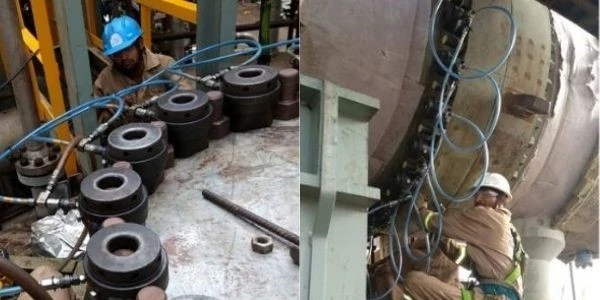Knowing that there are very few articles explaining the benefits of bolt tensioners, this article will explore on what benefits customers gain from bolting with a stud tensioner. First, we will explain the operation of a bolt tensioner and then move to the benefits it offers.
Following up from our previous article, which briefly explained hydraulic bolt tensioners. The article spoke about the components, design, and function of every bolt tensioning component. We all know the significance of a bolted connection, it can impact the plant efficiency, integrity, and reliability. To enhance the overall productivity onsite, plants adopt modern technologies that minimize shutdown time and avoid hand injuries. Understanding that practicing conventional bolting methods can risk injuries that affect the shutdown schedules, hydraulic bolt tensioning offers the advantage by delivering the industry’s highest level of safety, accuracy, and productivity on all critical joints.
A stud tensioner is an assembly of Puller, Load Cell, Bridge & Socket. The socket is placed on the nut and the load cell & bridge are placed on top of both. To begin tensioning, the bolt length needs to be one dia above the nut projecting out. All bolt tensioners are connected to hydraulic hoses through which the pressure is passed on. Hydraulic load through the applied pressure is delivered across all bolt tensioners. Once the load is delivered, the operator uses a tommy bar to turn the nut rotating socket to tighten the nut firmly on to the joint surface. The tensioner pressure is then released to complete the bolt tensioning procedure.
Since we have discussed the operation of a bolt tensioner, we can now move to justifying the title of our article. “The benefits bolt tensioners offer”. Long answer short, operating with a bolt tensioner ensures leak-free joints and enhances safety on-site.
The long answer, conducting bolting operations with bolt tensioners reduces shutdown intervals improving the productivity and efficiency onsite. To achieve joint integrity with controlled bolting, we need to check that the bolts are preloaded to the desired load. This allows every component of the joint assembly consisting of flange, gasket & bolts to work under optimal operating condition.
There are no frictional forces involved when operating with a stud tensioner, as the tool tends to pull the bolt axially using external force. Unlike torque wrenches, bolt tensioners do not require reaction arms / reaction points as there is no side load or torsional stress associated with tensioners. When compared to other methods of bolting, it is the fastest way of tightening multiple bolts as the operations involve multiple bolts to be tightened/loosened simultaneously. The elimination of reaction arms avoids the risks of pinch point injuries making bolting through tensioners the safest option.
Bolt tensioners also delivers pure axial bolt stressing nearly without shear stress which eliminate the chances of errors like unsafe connections, over dimensioned bolts, or unevenly tensioned flanges.
About TensionPro Tensioners
An early adopter of modern bolting technologies, the TensionPro team has a combined experience of more than 90 years to offer the most exhaustive portfolio of tensioning and bolt elongation measurement tools. The team specializes in offering customized solutions based on the customer’s requirements and the application. Offering simple bolting solutions, the team is known to resolve complex bolting problems thorough research, analysis, and design. Easy to use and simple to assemble, these tools can be hand-assembled in minutes.
We hope this article helped you understand the benefits of bolt tensioners and the operation of the same. Visit us next time for more knowledge sharing articles on industrial bolting.


